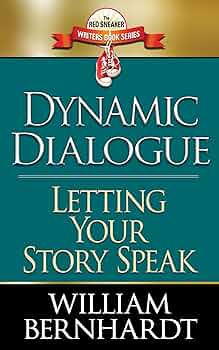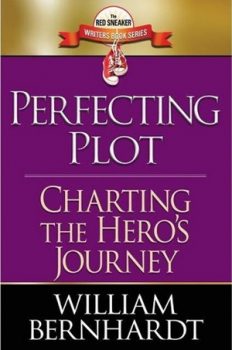Writing Advice: Dynamic Dialogue (Red Sneaker Writers)
 I started reading William Bernhardt’s Ben Kincaid books back in the mid-nineties. I seem to recall I went on a ‘lawyer’ kick and read him, Steve Martini, and Robert K. Tannenbaum. But years later, Bernhardt made a bigger impact on me with his Red Sneaker Writers series. These slim volumes with the brightly attractive colors are jam-packed with great writing advice. The first book I read was on story structure, and I think it’s still my favorite. Though every one has been both interesting to read and thought-provoking. If I ever get my act together, I’ll add “taught me a lot.”
I started reading William Bernhardt’s Ben Kincaid books back in the mid-nineties. I seem to recall I went on a ‘lawyer’ kick and read him, Steve Martini, and Robert K. Tannenbaum. But years later, Bernhardt made a bigger impact on me with his Red Sneaker Writers series. These slim volumes with the brightly attractive colors are jam-packed with great writing advice. The first book I read was on story structure, and I think it’s still my favorite. Though every one has been both interesting to read and thought-provoking. If I ever get my act together, I’ll add “taught me a lot.”
I’ve read through a couple of them more than once, making notes on paper (I CANNOT highlight a physical book. I’m incapable of it). Last year, I decided to be a little more systematic and I went through EVERY title, be it Theme, Plot, Character – all of them: and I outlined the key points in each chapter. I printed them all out and have a very cool binder. Which, if I ever actually sit down and write a novel, will be of great use.
I sent one of the outlines to him, telling him that I’d like to include it in a Black Gate post, promoting the series. He kindly granted his permission. Today, it’s the third outline in this series.
I’m fortunate that many actual, real, Writers (note the capital ‘W’) with books you can buy on Amazon, or at bookstores (if you can find one that is still in business), are friends of mine. And they are FAR more qualified than I am to talk abut writing advice. I think I hold my own as a Black Gate blogger, and there are worse Sherlock Holmes short stories out there than mine (And certainly better ones!). But my unfinished novel is just a bunch of words strung together, until I finish it.
 But I’ve read a lot of books on writing – fiction and screenplays. And I’ve come across a lot of useful ideas, suggestions, thoughts, and advice, from folks such as Lawrence Block, Tony Hillerman, William Martell, Syd Field, Robert Randisi, Chris Vogler (though I’m more apt to go to the original source material from Joseph Campbell), and James Scott Bell – to name a few without actually looking at my bookshelves. There are quite a few more, but my education would be incomplete without the Red Sneaker Writers books from Bernhardt. He writes in a clear, amusing, understandable, useful, manner. I can’t imagine not picking up at least something from each book. And I think you’re going to learn more than that.
But I’ve read a lot of books on writing – fiction and screenplays. And I’ve come across a lot of useful ideas, suggestions, thoughts, and advice, from folks such as Lawrence Block, Tony Hillerman, William Martell, Syd Field, Robert Randisi, Chris Vogler (though I’m more apt to go to the original source material from Joseph Campbell), and James Scott Bell – to name a few without actually looking at my bookshelves. There are quite a few more, but my education would be incomplete without the Red Sneaker Writers books from Bernhardt. He writes in a clear, amusing, understandable, useful, manner. I can’t imagine not picking up at least something from each book. And I think you’re going to learn more than that.
He starts each chapter with a neat quote. And each chapter ends with a couple Highlights, which I think of as Key Points. And also a couple of exercises to help you move forward. For each book, I took all the Key Points and turned them into an outline. And I spaced them out, so that I can write notes and comments in them. I’m pretty pleased with myself!
So what follows, is my outline for Dynamic Dialogue: Letting Your Story Speak. Of course, reading the book is much better, but what I wanted to do with this post was give you an idea of what one of the books contains. And what you can learn from it. I like Bernhardt’s tone, and sense of humor. Which makes learning easier for me. Except that I’m so thick-headed…
So, go ahead and read on through this outline. And check out all the books at his web page. Plus his other works, of course! You can subscribe to his free Red Sneaker Writers newsletter. I have all of the books in paperback, and they’re worth $7.99 each. The ebooks are usually only $2.99, and I HIGHLY suggest finding one or two that you want to check out and giving them a try. For me, Story Structure, and Character, are the two more ‘building blocks’ books, with the others to improve my writing ability. But you can start anywhere.
And since I started outlining these, Bernhardt recorded each one as audiobooks. I bought Story Structure, and it’s a good listen. As you know, you can’t always read; the complaints from the people I drive in my carpool… ha ha ha. So, check out a volume in print, digitally, or listen to it. I think you’ll want to get another one.
Links to the prior installments – as well as other writing thoughs I’ve had – below.
DYNAMIC DIALOGUE: LETTING YOUR STORY SPEAK
I – DEFINING DIALOGUE
1 – Dialogue is not conversation – but it should sound conversational.
2 – Dialogue is critical to engaging, well-paced fiction.
3 – Dialogue can help reveal characterization and motive, set the mood or tone, intensify the conflict, speed up the pace, establish setting, or suggest theme.
II – DIALOGUE FUNDAMENTALS
1 – The best dialogue propels the story forward.
2 – Good dialogue is compressed and economic.
3 – Good dialogue must have direction and purpose.
4 – Dialogue should not call attention to itself.
III – DIALOGUE TECHNIQUE
1 – Every time the speaker changes, start a new paragraph.
2 – Punctuation goes inside the quotation marks.
3 – Don’t confuse the end of the quote with the end of the sentence.
4 – Dashes indicate an interruption. Ellipses indicate pauses, hesitation, or trailing off.
5 – Avoid using character names in your dialogue – and your attributions.
IV – ATTRIBUTIONS
1 – The simplest attribution is usually the best.
2 – Don’t include an attribution unless it’s necessary.
3 – Use “said” substitutes sparingly.
4 – Don’t use the attribution to include information that should be obvious from the dialogue itself.
5 – Don’t break up the dialogue with pointless stage directions.
6 – Don’t have people speak in ways that words cannot be spoken.
7 – Use adverbs in dialogue attributions sparingly, and only for a good reason.
8 – Don’t use Tom Swifties unless your goal is to make your reader laugh.
V – DIALOGUE TABOOS
1 – Use exclamation points sparingly – if at all.
2 – Use profanity sparingly – if at all.
3 – Use slang sparingly – if at all.
4 – Use phonetic spellings sparingly – if at all.
5 – Reading your dialogue aloud is not the best way to determine whether it works. Read it slowly and silently, trying to reproduce the experience of the reader.
VI – DIALGOUE CHOREOGRAPHY
1 – Beats are the bits of action interspersed through a scene.
2 – Beats typically involve physical action or gestures, but they can involve a character’s internal thoughts.
3 – Beats should do one of the following (and if they don’t, take them out):
- Replace monotonous or intrusive dialogue tags;
- Lend variety to the pacing of the dialogue;
- Subtly provide the reader with information about a character’s emotional state;
- Reinforce or tie the dialogue to the character or the setting; and
- Suggest a change in a character’s thinking or emotional direction.
VII – CHARACTER CHARISMA
1 – Backstory and exposition may be more tolerable in dialogue- but don’t overdo it.
2 – Every character should have a distinctive voice.
3 – The best way to make your characters interesting is to give them something interesting to say.
VIII – TEXTURED DIALOGUE
1 – The best dialogue has emotional impact.
2 – Humorous dialogue enlivens almost any scene.
3 – Dialogue targeting emotionally sensitive spots makes for engaging reading.
4 – The best dialogue illuminates and draws into focus some important aspect of character or plot.
5 – Figurative language, such as similes and metaphors, can create memorable dialogue.
6 – Employing parallelism to create syntactic symmetry or cadence can result in stirring or inspirational dialogue.
7 – Dialogue planted to setup or payoff can provide powerful moments of resolution, closure, and emotional resonance.
Other Posts on Writing
Red Sneaker Writers: Structuring Your Story
Red Sneaker Writers: Perfecting Plot
Ya Gotta Ask – My Writing Career
RPGing is Storytelling
Don’t Start at the Start

Bob Byrne’s ‘A (Black) Gat in the Hand’ made its Black Gate debut in 2018 and has returned every summer since.
His ‘The Public Life of Sherlock Holmes’ column ran every Monday morning at Black Gate from March, 2014 through March, 2017. And he irregularly posts on Rex Stout’s gargantuan detective in ‘Nero Wolfe’s Brownstone.’ He is a member of the Praed Street Irregulars, founded www.SolarPons.com (the only website dedicated to the ‘Sherlock Holmes of Praed Street’).
He organized Black Gate’s award-nominated ‘Discovering Robert E. Howard’ series, as well as the award-winning ‘Hither Came Conan’ series. Which is now part of THE Definitive guide to Conan. He also organized 2023’s ‘Talking Tolkien.’
He has contributed stories to The MX Book of New Sherlock Holmes Stories – Parts III, IV, V, VI, XXI, and XXXIII.
He has written introductions for Steeger Books, and appeared in several magazines, including Black Mask, Sherlock Holmes Mystery Magazine, The Strand Magazine, and Sherlock Magazine.
Sounds like a good book to try.
I need all the writing help I can get. That first book, on STory Structure, is great. It captures the tone of the series (which I love), and lays down fundamentals. Book two, on Characters, is also pretty foundational.
And each book is around 85 pages. So, you feel like you’re making progress. Even good books on writing can feel like work to read. These flow. And the end chapter stuff is neat.
Flow definitely helps in any sort of instruction book! So does accordance with practical experience. Your outline of the dialogue book tells me his instruction comports with what actually happens in the good books, because I only disagree with two of the points– and both of the disagreements are purely conditional. That makes me willing to trust that he knows whereof he speaks in the other books. Thank you for sharing your note-taking outline.
You mentioned that he provides exercises for progression. Do the exercises tend to stand alone? Or are they the sort that build on each other, further developing the same work item?
The exercises tie directly in to that chapter (of course). I feel they build on the same item. But of course, it’s rather restricted, since each book covers only one topic. So, you’re not really doing Plot exercises in Premise. Or developing Theme in Dialogue. But I think they’re inter-related pretty well.
Thanks, Bob, for the heads up on this book (and the series). I appreciate your outline. It helped explain the contents of the book better than a short summary. I look forward to reading (and marking up!) the book – it came in the mail today. And will most likely get the rest of the series. Thanks again for all the great articles.
Sure thing. I read a bunch of William’s thrillers way back. He’s a good writer. Which led me to this series. And he’s personable amusing – they are enjoyable to read. And that’s a great aid in learning. Well, for me it is.
Enjoy the read! I just re-read Plotting, am re-reading Story Structure now.
That Structure one is such a sound, fundamental book. The others all come of that for me. I STILL don’t really get Premise, so I’ll be reading that one again.
If you don’t mind, pop back in after you read the new book and leave your thoughts on it. I’d like to hear them.
And honestly – I just love how the covers look. Makes me like the books even more.